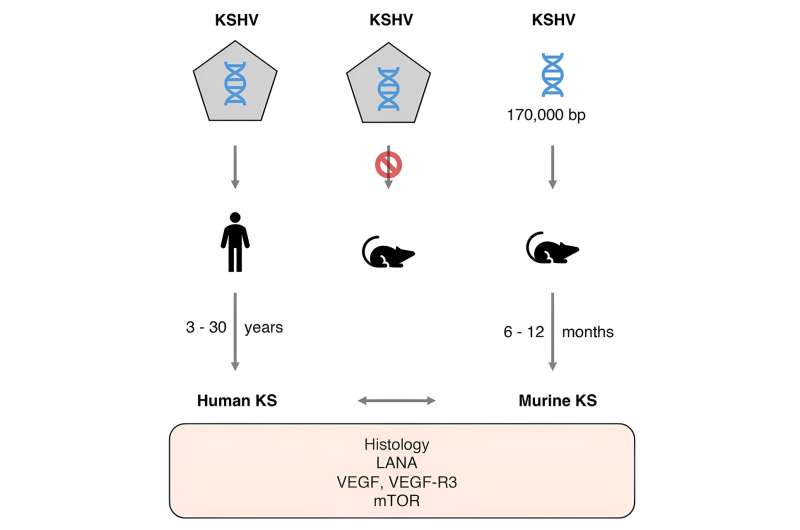This article has been reviewed according to Science X's editorial process and policies. Editors have highlighted the following attributes while ensuring the content's credibility:
fact-checked
peer-reviewed publication
trusted source
proofread
Kaposi sarcoma discovery and mouse model could facilitate drug development

Researchers at UNC Lineberger Comprehensive Cancer Center, after decades of research efforts, have developed a mouse model of Kaposi sarcoma that could be key to the development of new drugs to treat the disease. Kaposi sarcoma is a cancer that is the most common cancer in people living with HIV.
The findings appear in Cell Host & Microbe.
"This is an important development as we have created the first animal model ever of Kaposi sarcoma. Animal models are essential to move new drugs from the laboratory bench into clinical trials," said UNC Lineberger's Dirk Dittmer, Ph.D., senior corresponding author, co-leader of the UNC Lineberger Virology Research Program and director of the UNC Viral Genomics Core. "Before this, only repurposed drugs from other cancers were used to treat Kaposi sarcoma, but now we can start investigating entirely new compounds to help treat what can be a lethal cancer."
About 20% of all human cancers arise from viruses or require viral infection as an essential cofactor. The Kaposi sarcoma-associated herpes virus (KSHV) was discovered in 1994 and is associated with Kaposi's sarcoma as well as B-cell cancers. KSHV-associated diseases affect internal organs and are ultimately fatal. In the U.S., the diseases are found primarily in immunosuppressed people such as those who are HIV-positive or are transplant patients.
Worldwide, an estimated 34,270 cases of Kaposi sarcoma were diagnosed, and 15,086 deaths reported in 2020, with twice as many cases and deaths occurring in men compared to women. Africa accounted for 73% of new cases and 86.6% of the deaths from Kaposi sarcoma worldwide. The disease is endemic and not HIV-related in some southern and eastern African countries.
Aside from animal models, one way to study cancer is to look at tumor cells in the lab. But according to Dittmer, Kaposi sarcoma tumor cells are very finicky and dependent on signaling molecules and blood supply, which is why they don't survive in a laboratory culture dish. Therefore, researchers have been focusing on developing animal models that would mimic—as closely as possible—the disease in humans.
One of the challenges the researchers faced in developing their model was the fact that two types of genes are transcribed into proteins in the Kaposi sarcoma mouse model. Normally when a virus infects a cell, the cell dies as the virus replicates, which is a process called cell lysis; the genes that are needed for the virus to propagate itself are lytic genes. Cancer viruses are different as they enter a quiet state, called latency, where only the genes that help the infected cell survive are expressed. The mouse model the researchers developed is complex as a bit of both types of genes were needed.
Cervical cancer and its related virus, HPV (human papilloma virus), offer a good comparison for the challenge of developing a Kaposi sarcoma mouse model. The KSHV genome is 20 times larger than HPV. HPV has two cancer-causing genes, E6 and E7, so to mimic the disease in animals, researchers only needed to design two mice, one for each gene. KSHV may have as many as 10 cancer-causing genes that all work together so it would be way too difficult to develop that many mice, hence the virtue of their single model, Dittmer noted.
"Another of the key virtues of our new mouse model is that it helps us understand angiogenesis, or new blood vessel formation. Without angiogenesis cancer cells are deprived of oxygen and die," Dittmer said. "In this mouse model, we can study angiogenesis blocking drugs better than ever before. If new drugs work against Kaposi sarcoma, they will also likely work against lesser-angiogenic tumors, which would be a major plus."
For next steps, the researchers hope that others will pursue drug and vaccine development based on a new understanding of fundamental aspects of KSHV provided by their mouse model, including possible development of a much-needed primate model for human KSHV and Kaposi sarcoma.
More information: Sang-Hoon Sin et al, The complete Kaposi sarcoma-associated herpesvirus genome induces early-onset, metastatic angiosarcoma in transgenic mice, Cell Host & Microbe (2024). DOI: 10.1016/j.chom.2024.03.012

















